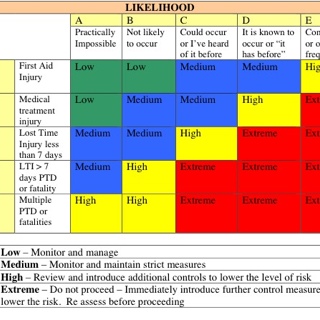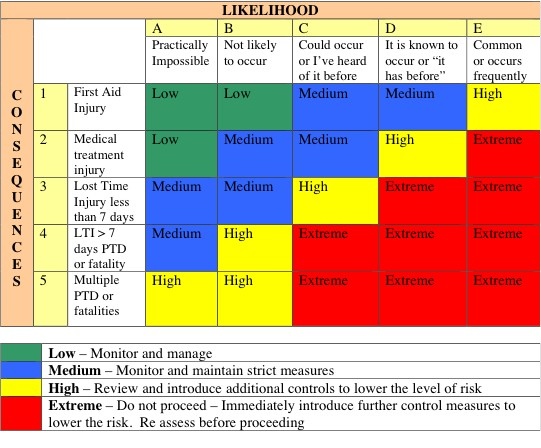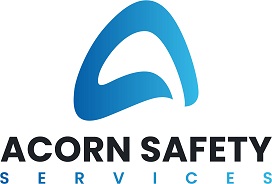Information
-
Conducted on
-
Work site location
-
GeoOp job reference number
-
Document No.
-
Person assessing
-
Lic no.
-
Other company personnel onsite
Common Risks
-
Please refer to the Risk Matrix table when making selections
http://www.ionmy.com.au/riskprocess/matrix.jpg -
Exposure to live parts?
-
Using the Risk Matrix table above, select the level of risk
-
Will you Isolate parts and test?
-
Explain why not
-
Working in confined spaces?
-
Using the Risk Matrix table above, select the level of risk
-
Have you received correct training?
-
You must decide if you can safely continue.
-
Working in a roof space, electrical, dehydration?
-
Using the Risk Matrix table above, select the level of risk
-
Will you Isolate power, rehydrate, break regularly?
-
Explain why not
-
Working in the sun, sunburn, dehydration?
-
Using the Risk Matrix table above, select the level of risk
-
Can you employ sun protection, rehydrate, break regularly?
-
Explain why not
-
Working at heights?
-
Using the Risk Matrix table above, select the level of risk
-
Do you have the correct safety equipment?
-
Explain how you will maintain your safety without the use of correct safety equipment
-
Slippery surface, work area?
-
Using the Risk Matrix table above, select the level of risk
-
Will you clean the surface?
-
Explain how you will mitigate this risk
-
Slippery surface, access?
-
Using the Risk Matrix table above, select the level of risk
-
Is there an alternate path, clean path?
-
How will you manage this risk?
-
Any animals?
-
Using the Risk Matrix table above, select the level of risk
-
Have client remove animals?
-
Explain suitable alternative
-
Poor hygiene?
-
Using the Risk Matrix table above, select the level of risk
-
Will client make Hygienic?
-
What measures will you take?
-
Is there too much mess or clutter to perform work?
-
Using the Risk Matrix table above, select the level of risk
-
Will the client clean it up?
-
Can you clean it up?
-
How else will you deal with this?
Site Specific Risks
-
Are there ANY other risks identified with this specific job?
-
Are you certain? Now is the time to take a look over the whole work site, to avoid any surprises.
-
Add each additional Risk, using the button to the right
Risk
-
The Risk Matrix table is available again here, for reference
http://www.ionmy.com.au/riskprocess/matrix.jpg -
Outline nature of risk
-
What is the likelihood of this risk occurring?
-
Now select the likely consequences if this risk were to eventuate
-
This level of risk is deemed LOW. Monitor and manage.
-
This level of risk is deemed MEDIUM. Be sure to monitor and maintain strict measures.
-
This level of risk is deemed HIGH.
Review and introduce additional controls to lower the level of risk. -
Now select the likely consequences if this risk were to eventuate
-
This level of risk is deemed LOW. Monitor and manage.
-
This level of risk is deemed MEDIUM. Be sure to monitor and maintain strict measures.
-
This level of risk is deemed HIGH.
Review and introduce additional controls to lower the level of risk. -
Now select the likely consequences if this risk were to eventuate
-
This level of risk is deemed MEDIUM. Be sure to monitor and maintain strict measures.
-
This level of risk is deemed HIGH.
Review and introduce additional controls to lower the level of risk. -
This level of risk is deemed EXTREME.
DO NOT PROCEED. Immediately introduce further control measures to lower the risk.
Re-assess before proceeding. -
Now select the likely consequences if this risk were to eventuate
-
This level of risk is deemed MEDIUM. Be sure to monitor and maintain strict measures.
-
This level of risk is deemed HIGH.
Review and introduce additional controls to lower the level of risk. -
This level of risk is deemed EXTREME.
DO NOT PROCEED. Immediately introduce further control measures to lower the risk.
Re-assess before proceeding. -
Now select the likely consequences if this risk were to eventuate
-
This level of risk is deemed HIGH.
Review and introduce additional controls to lower the level of risk. -
This level of risk is deemed EXTREME.
DO NOT PROCEED. Immediately introduce further control measures to lower the risk.
Re-assess before proceeding. -
Outline what measures (if any) will be implemented to control this risk
Uncontrolled Risks
-
Of all the risks listed above, are any still un controlled?
-
Work cannot continue without contacting your office/foreman/manager for further guidance. Outline the reasons if work will progress with 'status quo':
Machinery
-
Is there heavy plant being used?
-
List the plant type, operator and licence no for each, below:
Plant
-
Plant type
-
Operator
-
Lic no
Switchboard works Running Checklist
-
Following is a list of the electrical conductors you may have worked on. Were they removed?
-
A phase
-
Has the conductor been Reinstated and tested ok?
-
B phase
-
Has the conductor been Reinstated and tested ok?
-
C phase
-
Has the conductor been Reinstated and tested ok?
-
Main Earth
-
Has the conductor been Reinstated and tested ok?
-
Main Neutral (Remove MEN also)
-
Has the conductor been Reinstated and tested ok?
-
MEN (Remove Main Neutral also)
-
Has the conductor been Reinstated and tested ok?
-
Add each circuit / CB as required, now
Circuit/ CB#
-
Circuit/CB Name
-
Removed?
-
Has the conductor been Reinstated and tested ok?
SIGN OFF
-
To my best judgement, a sound Risk Assessment has been conducted on this job and no work will be done in any area where a risk can not be controlled.
-
Signature
-
All electrical work performed on this job is complete and tested I.A.W. AS/NZ 3000.
-
Signature













